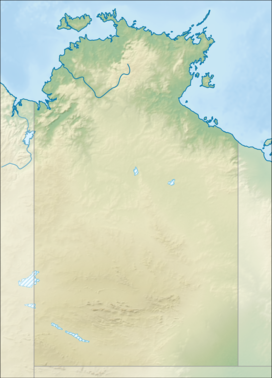For the cattle station formerly known as Mount Conner, see Curtin Springs.
| Mount Conner | |
|---|---|
 Mount Conner seen from the road to Uluru / Ayers Rock Mount Conner seen from the road to Uluru / Ayers Rock | |
| Highest point | |
| Elevation | 859 m (2,818 ft)AHD |
| Coordinates | 25°29′34″S 131°53′52″E / 25.492807°S 131.897828°E / -25.492807; 131.897828 |
| Naming | |
| Etymology | M. L. Conner |
| Geography | |
 | |
| Location | Petermann, Northern Territory, Australia |

Mount Conner, also known as Artilla or Atila, or tongue-in-cheek as Fooluru, is a mountain located in the southwest corner of the Northern Territory of Australia.
Location and description
Mount Conner is located 75 kilometres (47 mi) southeast of Lake Amadeus, in the locality of Petermann. It lies within the Curtin Springs cattle station in Pitjantjatjara country, close to the site of the Kungkarangkalpa (Seven Sisters) Dreaming.
Its height reaches 859 metres (2,818 ft) above sea level and 300 metres (984 ft) above ground level.
Names
Mount Conner was named after M. L. Conner by explorer William Gosse in 1873. Its Aboriginal name is "Artilla" or "Attila", believed to be associated with the "terrible ice-man" story.
It is also known by locals as "Fool-uru" or "Fuluru", owing to tourists sometimes confusing it with Uluru.
Geology
The sides of Mount Conner are blanketed by scree (talus) and its top is blanketed by colluvium. The base of Mount Conner is surrounded by alluvium.
The summit of Mount Conner, along with the summits of low domes in the Kata Tjuta complex and summit levels of Uluru, is an erosional remnant of a Cretaceous geomorphic surface. It is considered to be a classic example of an inselberg created by erosion of surrounding strata.
See also
References
- ^ "Place Names Register Extract for "Mount Conner"". NT Place Names Register. Northern Territory Government. Retrieved 14 June 2019.
- "Central Australia, 1940". SA Memory. State Library of South Australia. 29 October 2009. Retrieved 19 September 2015.
- "Seven Sisters Dreaming". 24 March 2014. Retrieved 19 September 2015.
- "Mount Conner". Encyclopædia Britannica Online. Encyclopædia Britannica. 2011.
- Patowary, Kaushik (13 June 2016). "Mount Conner: The Rock That Fools You". Amusing Planet. Retrieved 9 April 2023.
- Junker, Ute (4 March 2015). "'Fool-uru': The rock tourists think is Uluru". Stuff. Retrieved 14 April 2022.
- Young, DN, N Duncan, A Camacho, PA Ferenczi, and TLA Madigan (2002a) Ayers Rock, SG 52-8 map, 1:250 000 Geological Series (Second Edition), Northern Territory Geological Survey. scale 1:250 000, Darwin, Northern Territory Geological Survey, Australia.
- Young, DN, N Duncan, A Camacho, PA Ferenczi, and TLA Madigan (2002b) Ayers Rock, SG 52-8 Explanatory Text, 1:250 000 Geological Series (Second Edition). scale 1:250 000, Darwin, Northern Territory Geological Survey, Australia.
- Edgoose, CJ (2012) The Amadeus Basin, central Australia. Episodes. 35(1):257-263.
- Twidale, C.R. (2007) Ancient Australian Landscapes. Rosenberg Publishing, Kenthurst, New South Wales. 144 pp.
Additional sources
- Ayers Rock Geology Map (Map) (1st ed.). 1:250,000. Sheet SG52-8. Northern Territory Geological Survey. 1967.
- Ayers Rock Geology Map (Map) (2nd ed.). 1:250,000. Sheet SG52-8. Northern Territory Geological Survey. 2002.
- Johnson, David (2004). The Geology of Australia. Cambridge University Press. ISBN 0-521-84121-6.
Further reading
- Thompson, R B (1995). A Guide to the Geology and Landforms of Central Australia. Alice Springs: Northern Territory Geological Survey. ISBN 0-7245-2527-0.